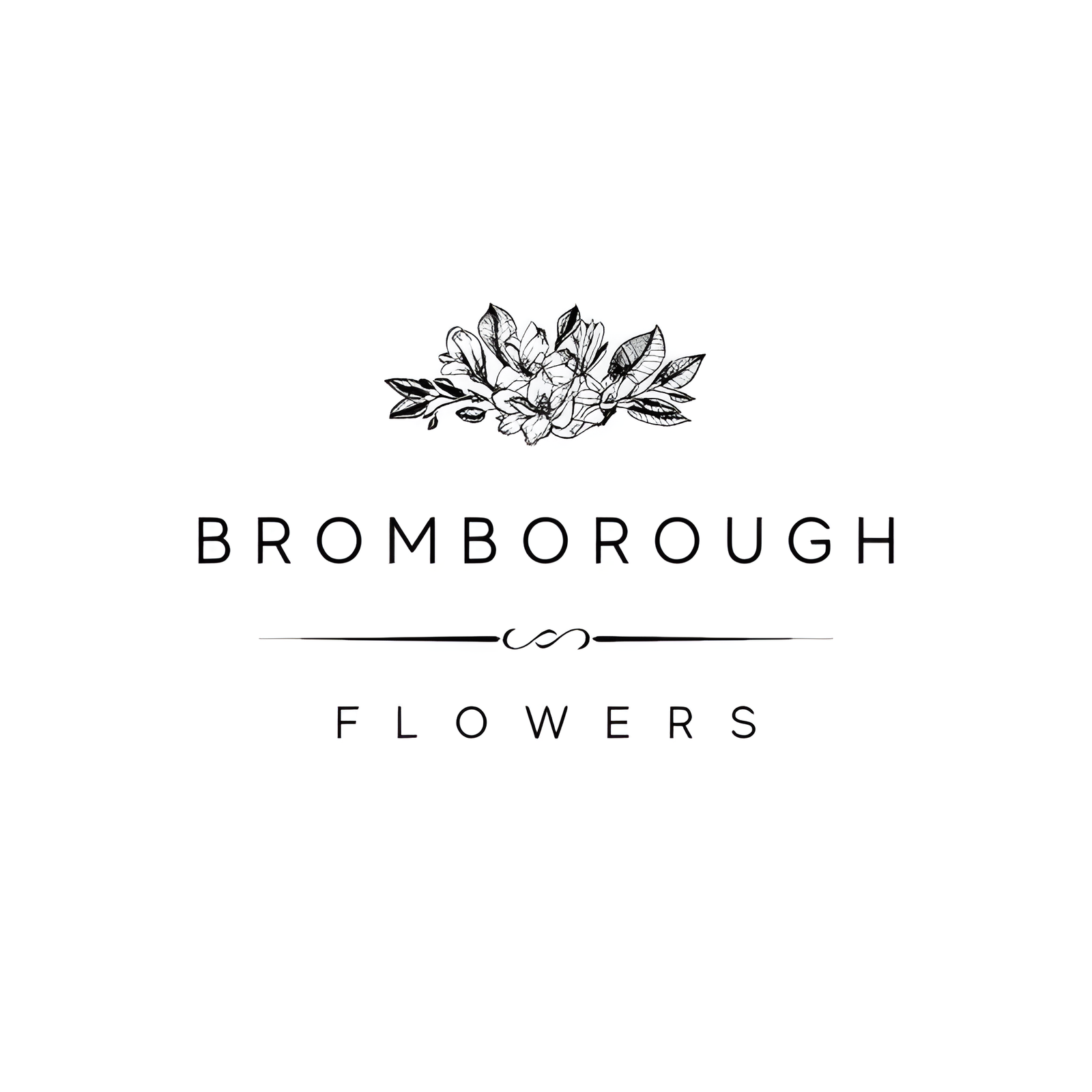Exploring the role of Helianthus, or sunflowers, in wedding decor opens a window into the intersection of natural beauty and meaningful symbolism. These flowers, with their striking golden petals and commanding presence, bring an air of rustic elegance to any nuptial celebration. Not only do they symbolize adoration and loyalty, but their versatility and seasonality make them a favored choice for summer and early fall weddings. How do these iconic blooms fit into the broader spectrum of wedding aesthetics, and what unique opportunities do they present for personalizing your special day?
Flower Overview
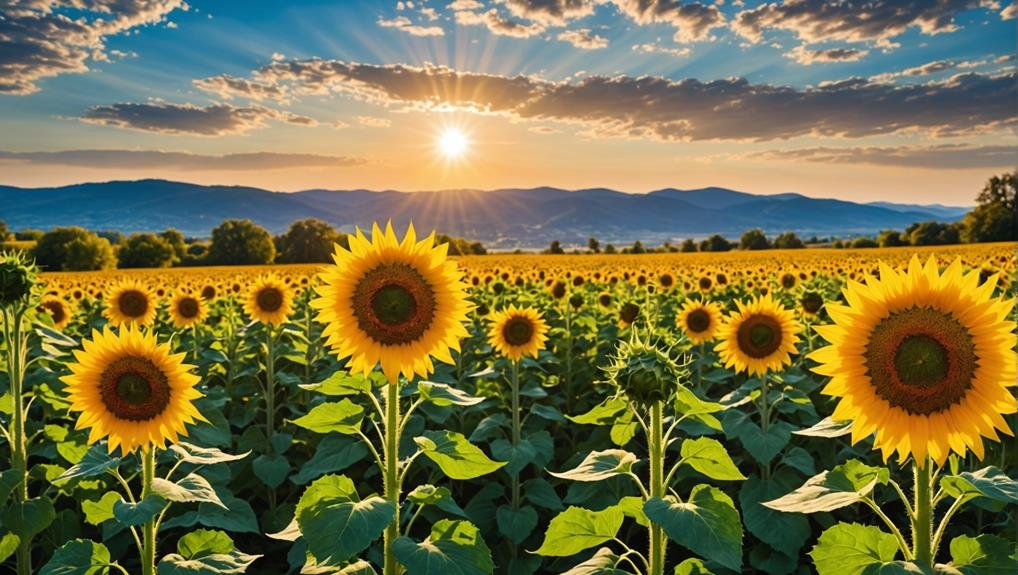
Sunflowers, belonging to the Asteraceae family and native to North America, are renowned for their striking resemblance to the sun and their unique heliotropic behavior. This characteristic, where the sunflower heads follow the sun from east to west during the day, adds a dynamic element to their already vibrant appearance. Known scientifically as Helianthus, these flowers are not only a staple in gardens and fields but also increasingly popular in wedding arrangements.
Sunflowers are cultivated extensively in Europe, where they serve multiple purposes, including the cut flower market, food production, and oil extraction. Their bright yellow petals and large, cheerful heads make them an excellent choice for wedding decorations, symbolizing adoration, loyalty, and longevity. This symbolism can resonate deeply with couples looking to infuse their ceremonies with meaningful floral arrangements.
The versatility of sunflowers is another reason for their increasing popularity in weddings. They can be used in various forms, from bouquets and centerpieces to decorative accents. With different varieties available, and stem lengths ranging from 55cm to 90cm, sunflowers provide both aesthetic appeal and practical options for diverse wedding themes and settings.
Physical Description
With their towering stems and radiant golden petals, Helianthus exhibit a striking and easily recognizable physical presence. Native to North America and belonging to the Asteraceae family, sunflowers captivate with their large, sun-like flower heads. These impressive blooms, often used in Sunflower Wedding Bouquets, can bring a touch of natural elegance to any wedding setting.
The stems of sunflowers vary in length, typically ranging from 55 cm to 90 cm, providing versatility in floral arrangements.
The flower heads of sunflowers feature a central disk surrounded by vibrant, petal-like ray florets, which are usually yellow but can exhibit subtle variations in color. Known for their heliotropic behavior, sunflowers follow the sun from east to west throughout the day, a characteristic that further enhances their allure.
Sunflowers are cultivated extensively in Europe not only for the cut flower market but also for food and oil production. Their robust stems and large, bright blooms make them a popular choice for adding a splash of color to wedding decor.
Whether used as standalone arrangements or mixed with other flowers, sunflowers can create a stunning visual impact, making them a favored option for bridal bouquets.
Available Colour Varieties
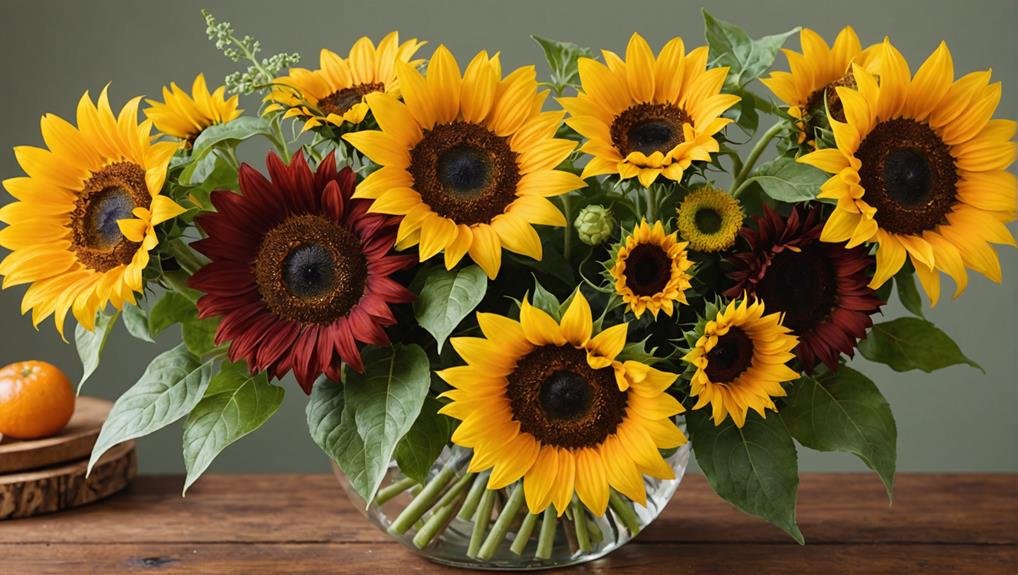
Available in a spectrum of hues, Helianthus offers versatility beyond the classic yellow, providing choices that range from pale pastels to vibrant bi-color combinations and even unique shades like red, orange, and brown. This diversity makes sunflowers an adaptable choice for any wedding color scheme, allowing couples to match their floral arrangements with their desired wedding colors seamlessly.
Primarily, sunflowers are known for their iconic yellow petals, which can vary from soft, pale yellows to rich, deep golden tones. These shades can add a warm, inviting ambiance to any wedding setting.
For those looking to introduce a touch of complexity to their floral designs, bi-color sunflowers—featuring yellow petals with dark centers—offer a striking contrast that can enhance the visual appeal of the décor.
Moreover, hybrid sunflowers extend the palette with unique colors such as red, orange, and even shades of brown, providing more options for creative wedding color schemes.
White or cream-colored varieties are also available, catering to couples who prefer a softer, more delicate aesthetic.
Additionally, sunflowers can be dyed or painted, offering an even broader array of vibrant and unconventional colors, ensuring a perfect match for any wedding theme.
Latin Name and Taxonomy
Known scientifically as Helianthus, sunflowers derive their name from the Greek words ‘helios’ meaning sun and ‘anthos’ meaning flower. This nomenclature aptly reflects the flower’s sun-like appearance and its heliotropic behavior, where it turns to face the sun. Belonging to the Helianthus genus within the Asteraceae family, sunflowers encompass over 70 species.
The taxonomy of Helianthus is intricate yet fascinating. As members of the Asteraceae family, sunflowers are classified as dicotyledonous flowering plants, characterized by their composite flower heads. These flower heads are a collection of numerous small florets clustered together, creating the iconic sunflower bloom.
Among the various species, Helianthus annuus stands out due to its widespread cultivation for seeds, oil, and ornamental purposes. The Helianthus genus is diverse, including varieties that range from towering giants to diminutive, ornamental cultivars. This diversity allows sunflowers to be versatile in their application, from agricultural crops to decorative elements in wedding bouquets.
In essence, the Helianthus genus not only contributes significantly to agriculture but also holds a cherished place in horticulture, making sunflowers a popular choice for various occasions, including weddings.
Geographical Origins
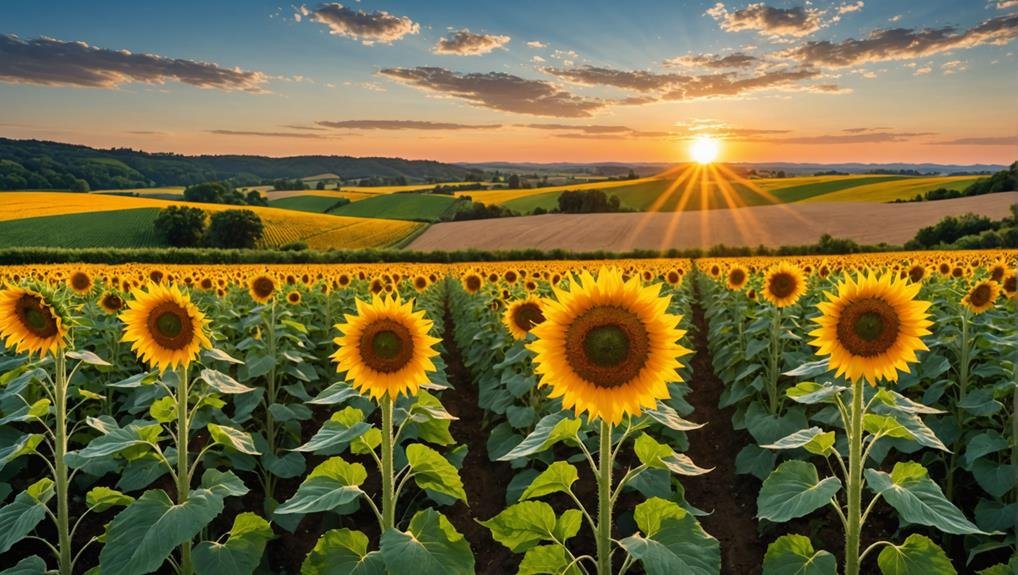
Sunflowers, originating from North America, have a rich history that spans thousands of years. Scientifically known as Helianthus, these vibrant flowers are native to the continent and were first domesticated by indigenous peoples. Their cultivation can be traced back to as early as 3000 BC, where they were grown not only for their aesthetic appeal but also for their seeds, which were used as a significant food source.
The geographical origins of sunflowers extend beyond North America, as their cultivation spread to Europe during the 16th century. Introduced by explorers, sunflowers quickly gained popularity in European agriculture. Today, they are widely cultivated across the continent, particularly in countries like Spain, France, and Italy, where they are grown for the cut flower market, food production, and oil extraction purposes.
Sunflowers’ heliotropic behavior—tracking the sun’s movement from east to west—further enhances their appeal and symbolic connection to the sun. This characteristic, combined with their robust nature and varying stem lengths (ranging from 55cm to 90cm), makes them a versatile choice for various applications.
Understanding the geographical origins of sunflowers provides insight into their global journey and enduring popularity, laying a foundation for appreciating their role in contemporary floral arrangements.
Season Availability
Understanding the geographical origins of sunflowers lays the groundwork for appreciating their seasonal presence, which typically spans from late summer to early fall. Peak presence of sunflowers occurs in September and October, a period when these vibrant blooms are at their highest quality and most affordable due to their abundance. This timing aligns perfectly with the late summer and early fall wedding season, making sunflowers a popular choice for wedding flowers.
During their peak season, sunflowers stand out for their vibrant and impactful appearance, making them ideal for a sunflower wedding bouquet. Their bold hues and striking forms bring a touch of warmth and joy to any wedding setting.
However, the presence of sunflowers may vary depending on location and local growing conditions, which can influence both the quality and cost of these blooms.
Couples planning their wedding floral arrangements should consider the season presence of sunflowers to ensure they are getting the best quality flowers. By aligning their wedding date with the peak season of sunflowers, they can take advantage of the natural abundance and superior quality of these stunning blooms, enhancing the overall aesthetic of their wedding day.
Growing Conditions
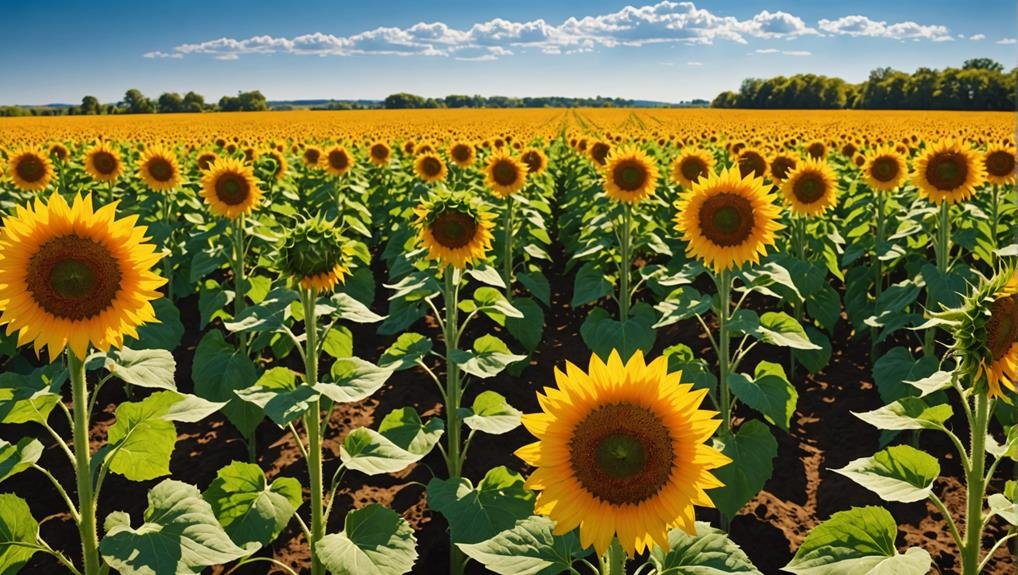
Optimal growing conditions for sunflowers include full sun exposure and well-drained soil, ensuring they receive 6-8 hours of direct sunlight daily. These conditions are essential for the best growth and vibrant blooms that make sunflowers a popular choice for weddings and gardens alike.
Sunflowers are remarkably drought-tolerant once established, requiring minimal watering. They thrive in USDA Hardiness Zones 1-11, making them versatile across various climates. Additionally, sunflowers are annual plants, meaning they complete their life cycle in one growing season, which is advantageous for those looking to refresh their garden yearly.
For those interested in growing sunflowers, consider the following key points:
- Planting Depth: Sow sunflower seeds about 1-2 inches deep to ensure proper sprouting.
- Spacing: Space seeds about 6 inches apart to give each plant ample room to grow.
- Height Variety: Depending on the variety, sunflowers can reach heights between 3-10 feet, offering flexibility in garden planning and design.
Sunflowers’ wide, showy flower heads are a tribute to their robust growth when provided with the right growing conditions. Easy to grow from seed, they are an excellent choice for both novice and experienced gardeners, enhancing any landscape with their bright, cheerful presence.
Cultural Significance
Exploring the cultural importance of sunflowers reveals their deep-rooted symbolism of adoration, loyalty, and happiness across various societies. Historically, sunflowers have been revered for their association with longevity, energy, faith, and devotion. These attributes make them an especially meaningful choice for wedding themes, infusing the event with positive energy and deep emotional resonance.
Sunflowers’ bright and cheerful appearance can enhance the ambiance of wedding ceremonies, making them a popular choice for floral arrangements. Their symbolism of happiness and loyalty aligns perfectly with the sentiments expressed during such significant occasions. Incorporating sunflowers into wedding decor, from centerpieces to wedding stationery, adds a rustic charm and personal touch that many couples find appealing.
Furthermore, the use of sunflowers in floral arrangements can set the tone for a vibrant and welcoming atmosphere, resonating with the joy and commitment celebrated in weddings. These flowers can be seamlessly integrated into various aspects of the wedding theme, creating a cohesive and aesthetically pleasing experience for guests. By choosing sunflowers, couples not only embrace a flower with rich cultural importance but also elevate the overall ambiance of their special day.
Typical Use in Weddings
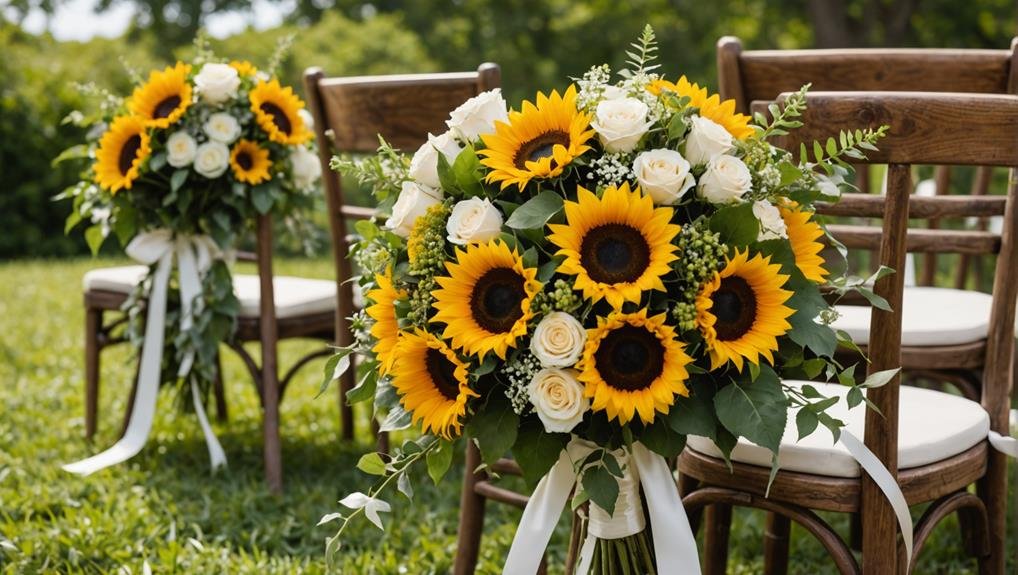
Sunflowers, with their vibrant color and natural beauty, are a versatile choice for wedding flower arrangements, perfect for creating a relaxed and rustic atmosphere. Their bright yellow hues and large, cheerful blooms make them an ideal addition to a variety of wedding settings, particularly those held in the summer or early fall when sunflowers are in full bloom and readily available.
Sunflowers can be used in numerous ways to enhance the aesthetic of a wedding. Here are a few popular uses:
- Wedding Bouquets: Sunflowers can be the focal point of bridal and bridesmaid bouquets. They can be arranged in natural, wild styles for a more bohemian look or in neat, round formations for a classic touch.
- Centerpieces: These flowers can create striking centerpieces for reception tables. Combined with greenery and other seasonal blooms, sunflowers add a touch of warmth and brightness to any table setting.
- Aisle Decorations: Lining the aisle with sunflower arrangements can create a welcoming path for the bride’s entrance. They can be placed in rustic containers like wooden crates or mason jars to enhance the ambiance.
Incorporating sunflowers into wedding bouquets and other floral arrangements offers a cost-effective and visually stunning option for couples looking to personalize their special day.
Alternative Flower Types
When pondering options beyond sunflowers for wedding arrangements, roses, dahlias, lilies, and peonies provide a diverse array of colors, shapes, and textures. These substitute flower varieties allow couples to craft unique and personalized bouquets that can complement various wedding themes and color palettes.
Roses, with their timeless appeal and wide spectrum of colors, symbolize love and romance, making them a perennial favorite for weddings. Dahlias, known for their intricate petal arrangements and vibrant hues, convey elegance and sophistication. Lilies bring a touch of purity and grace to any floral arrangement, with their striking form and pleasant fragrance. Peonies, celebrated for their lush, full blooms, evoke a sense of prosperity and good fortune.
When selecting alternative flower types to sunflowers, it is essential to take into account the seasonality of the flowers, as well as the overall theme and aesthetic of the wedding. Mixing and matching these flowers can create visually stunning and meaningful arrangements that reflect the couple’s personal style.
Whether opting for the classic charm of roses or the bold beauty of dahlias, each alternative flower type offers distinct advantages that can enhance and elevate the floral decor of a wedding ceremony.
